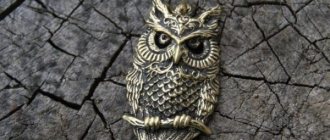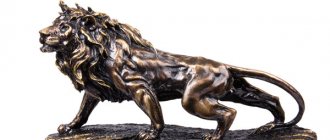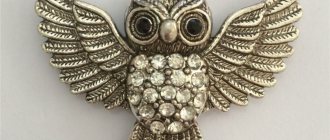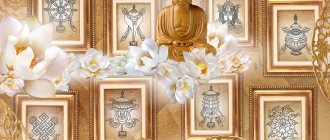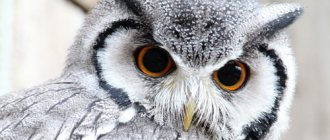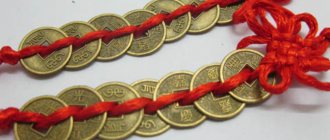The owl is a very meaningful symbol. Let's find out more about the values.
The symbolism of the images of animals and birds was incomprehensible to man for a long time, since many representatives of the fauna had abilities beyond his control. A nocturnal bird, the owl, moving on its wings absolutely silently, could distinguish objects in the darkness, turn its head as much as 360 degrees, thereby causing in people primitive fear, bordering on worship.
She was credited with the ability to change appearance, use magical skills, bring death, separation, evoke feelings of lust, and, at the same time, have wisdom and the gift of foresight. To find out what the owl symbolizes and how its image is perceived by the modern world, let’s read the material below.
Magnet for cash flow into the house in the form of an owl
There is a belief that placing an owl figurine in your home attracts money. Especially if the figurine is located in close proximity to the place where funds are stored, thus ensuring reasonable management of finances, an influx of wealth greater than waste.
The following home talisman for finance is very popular - an owl figurine sitting on a money tree. The meaning here is double - the money tree brings prosperity, the owl protects funds from an unkind glance and ill-considered actions.
For well-being
- The Slavs worshiped the owl, considering it the guardian of treasures and valuables from the bowels of the earth.
- By placing a figurine of an owl and a money frog clutching a coin in its mouth next to each other, the effect of the talismans will double, providing greater prosperity to the home and family.
The amulet is also useful for the younger generation: a figurine of an owl, “settled” in the nursery, will set the children up to strive to use money wisely and economically.
Rescue from mistakes
In the diversity of what the owl symbolizes, Chinese culture offers an interesting option. In it, she belongs to the good characters. Wise, careful, prudent. She can often be seen sitting on a money tree. This amulet protects its owner from unreasonable expenses, unprofitable investments, and helps to save.
Any amulet in the form of this feathered creature, placed in a children's room, will help its little owner - he will obey his parents, stop being naughty, and come to his senses.
Owl in feng shui
Feng Shui symbols with the image of an owl are strongly recommended to be placed in the north-eastern area of the room or on the desktop. The best option - a trio of owls - will protect the home and family members from all evil.
The northern white owl takes care of family traditions; as a rule, figurines or drawings of a white owl are placed in the place of greatest concentration of household members - the living room or bedroom. This amulet has the ability to absorb the positive or negative energy of others, and then return it to its owners. Therefore, you should not start arguments near the symbol, otherwise they will return, and also leave the “bird” in deserted corners of the room where heat does not penetrate.
In feng shui
The influence of a talisman placed in the workroom, where spending and income are discussed, will be beneficial on the owner of finances. A figurine of an owl with open wings, made of white or transparent material, will help you climb the career ladder and guarantee success.
The symbol of the owl is the gift of wisdom and protection from imprudence
The ancient Greeks identified the owl with Pallas Athena, the goddess of wisdom, patroness of art and witchcraft. The same tradition found its response in Russia, which is why the image of an owl on a stack of books is considered a symbol of knowledge, erudition and wisdom; the same meaning applies to an owl with an open book. Many educational institutions have chosen the owl as their emblem.
The natives of North America worshiped the totem of the owl - a wise and perspicacious creature; for its powerful beak and sharp claws, the bird was compared in strength even to an eagle. It was believed that owl feathers stuck into a headdress could protect its owner from harm.
In families where there are students, the owl is solemnly given a place on the desk or bookshelf; you can hang a drawing of the bird on the wall, thus ensuring in children a persistent thirst for knowledge, academic success and the desire for sound actions. By taking a small figurine of an owl to the exam or wearing jewelry with a picture of a bird, you can count on the amulet to help you concentrate at the right time.
For students
Mischievous people who do not want to study diligently or obey their parents will be put in the right mood by a figurine of a white owl with folded wings. It will help you develop perseverance, reveal the secrets of knowledge and bestow wisdom. A similar amulet in the form of a keychain, pendant or bracelet will have a beneficial effect on fidgets within the school.
For wisdom
If the whole family has already received an education, the symbol of an owl with an open book or on top of a stack of books will help consolidate knowledge and use it to their advantage.
Range, habitats
Scientists classify the polar owl's habitat as circumpolar, which means its ability to adapt to life in the Arctic zones of both hemispheres. The bird settles in tundra areas of such continents as Eurasia and North America. It can also be found on the Arctic islands of Greenland, Novaya Zemlya, Wrangel, Bering and some others.
But birds prefer to winter in the more southern poles. When migrating, they even reach the zone of deciduous forests. For wintering it chooses open areas where there are no populated areas. The time for flight and settling on the ground takes from the last days of September to mid-October. The return flight takes place at the end of March, the owls return to the Arctic to breed and breed.
This is interesting! In rare cases, polar owls prefer to stay for the winter in the places where they nested. As a rule, their overnight roosting areas are areas with a thin layer of snow or ice.
Return to content
Owl is a sign of witches and death
Ancient man was in awe of the owl. There was no state that did not consider this night bird a messenger from the world of the dead, possessing secret knowledge and the gift of divination.
- In medieval tales, witches and witches had the ability to take the form of an owl and perform their dark deeds at night.
- In the cultural traditions of China, India, Egypt, America and Japan, the owl is the personification of death.
- The Chinese people are convinced that night birds can bring evil, incite dishonorable acts, cause children to feel disrespect for their parents, and call for death. Therefore, her image is often present on funeral vessels.
- In Europe, there is a belief that the owl is the patroness of dark magic and hermitage.
- In America, the symbol of the goddess of strife and poverty, Astarte - an angry squinting owl with horns on her head - is placed on the dollar bill.
Owl
The Egyptians depicted the owl as the messenger of the night, cold, passivity and even death. Modern perception of owl symbolism is more inclined towards the positive beginning of the sign. For example, a figurine of an owl, brought into a home or decorating a person’s body, provides him with protection from evil entities and evil spirits. The owl's large eyes glow in the darkness, symbolizing spiritual radiance - this is what frightens everything otherworldly.
The presence of owl symbolism will help develop intuition, sense insincerity on the part of others, and predict their intentions and actions. The owl also helps the owner of the amulet to understand his own character and work through his negative traits.
Northern shamans used the symbol of the white owl to heal the sick. Thus, an oak figurine of an owl will protect from any illness the one who touches it once a day with thoughts of a healthy life.
Basic information about the bird
The description of the polar owl should begin with the fact that this individual is the largest in its habitat. She is part of the order of owls. For a long time, scientists could not agree on what genus this representative of the owl family belongs to.
Description and distribution
The white owl is one of the largest birds. It has snow-white plumage with dark patches (speckles), ranging from deep black to light brown. The round head of the bird has a similar color, against which the large eyes of the predator with their bright yellow iris and black oval pupils contrast effectively.
As for the size of the bird, scientists provide the following information about the polar owl:
- The female snowy owl is larger than the male owl.
- On average, the weight of females is about 3 kilograms with a height of 70 centimeters.
- The weight of males varies in the range of 2−2.5 kilograms, height - 55 to 65 centimeters.
- The wingspan, which is very developed in owls, can reach 166 centimeters.
- The beak of the predator has a strong structure, black color and unusual plumage: these characteristic bristles prevent it from freezing.
- Males have much less streaking than females and young animals, which is why they appear lighter. Therefore, it is much easier for them to go unnoticed against the backdrop of snowy landscapes.
- Owl chicks hatch brown. They have sparse plumage that resembles down.
- The bird’s strong legs also have feathers, and very thick ones, which is why scientists nicknamed them cosmos. In fact, these “pants” were provided by nature: they save the owl’s paws from the cold and prevent them from freezing to the icy snow crust.
- The white owl is silent, but as soon as the mating season begins, the bird demonstrates screeching trills that are difficult for other people's ears to bear. In addition, she can produce piercing barks or even croaking screams, which bear little resemblance to the usual hoots.
- The white owl's head can rotate 270 degrees, giving it an almost unlimited view.
Very warm, water-repellent plumage and a thick undercoat, with which the predator is covered from head to toe, allow it to adapt to the harsh conditions of the tundra. Due to this, it has a fairly wide range. The bird is found in the north of the Eurasian (mainly in Russia) and North American continents, in Greenland and even on some islands lost in the waters of the Arctic Ocean.
At the same time, the snowy owl is considered a partially nomadic bird, since it does not accept long flights, preferring to move towards the south for the winter, but not too far from its usual habitat. When the Arctic winter sets in (usually this period falls in September-October), the bird flies to the more southern zone of the forest-tundra and steppes, most often choosing open areas. For this reason, it is almost impossible to find it in the forest, but near human settlements it is quite possible. If a predator is completely hungry, then it does not disdain scraps from garbage dumps and landfills.
Snowy owls return at the height of spring, although there are also those that do not fly away at all, adapting to the harsh conditions of the winter tundra. As a rule, these birds look closely at the areas surrounding them for a long time, choosing those where there is a minimum amount of ice and snow. An amazing feature of these birds is that they know how to defend their own territory. This also attracts smaller birds that cannot fend for themselves. As a result, many of them try to settle in the polar owl’s habitat, hoping that in this way they will protect themselves from large predators.
Diet and reproduction
The snowy owl is, first of all, an active predator that is content not only with small bugs, spiders and snakes, but also with larger prey. Thus, the owl's main diet consists of lemmings - small rodents from the hamster family with a weight not exceeding 80 grams. In just one year, an adult eats about 1,600 lemmings, swallowing its prey whole. There are many other things that the snowy owl eats. The predator is not averse to feasting on other mammals and animal products:
- White hares and pikas. To catch a large individual, the owl simply digs into it with its sharp, strong claws, waiting until the victim is completely exhausted and ceases to offer active resistance. After this, the bird finishes with it, eating it immediately on the spot, or tearing it into small pieces if the catch turned out to be too large.
- Other small predators. The owl's favorite food is ermine, although it can easily deal with larger Arctic foxes.
- Birds are also on the owl's menu. In particular, we are talking about species found in its habitat - geese, ducks and ptarmigan.
- Eggs. Any eggs can be used, even if they are not very fresh.
- Fish. If an owl cannot find food on land, it begins to look for it in an unfamiliar environment. Most often we are talking about coastal areas where you can profit from fish.
- Carrion. The owl does not disdain rotten meat, especially if the winter is too snowy and hungry.
Contrary to popular belief, the polar owl is not a nocturnal bird. She prefers to go hunting in the early morning hours or late evening. If you have to catch prey in the dark, then the predator can flutter in the air above its prey, reminiscent of another representative of its class - the kestrel. The owl prefers to look for prey from a height, launching after it or even hovering from above until it seems to it that the time has come to take more decisive action.
The mating season proceeds in different ways. While some individuals prefer to nest with only one pair for several years, others change partners every year. This season begins in March. Usually, it is the males who are the first to become active, choosing the area they like from 1 to 6 square kilometers and letting out a loud cry, notifying the entire area that the territory is occupied. Long trills warn females that they are ready to nest.
Naturally, this does not mean that other birds will not covet the marked territory. Therefore, owls often get into fights, which can end disastrously for one of the birds. To arrange their homes, they choose hills and other elevations where there is a minimum of snow.
The nest itself has nothing in common with structures familiar to forest birds. It is just a small depression in the ground, insulated with rags of plant origin and owl down.
It is noteworthy that owls try not to hunt near their nest, flying away from it at least 1 kilometer. This is another reason why many small birds and mammals try to stay close to the owl’s home. In the next season, the males try to acquire offspring within the same area, unless, of course, by that time a stranger appears in it or a person sets his traps.
In May, laying begins, despite the fact that the number of eggs in it will directly depend on the nutrition of the female. For example, in feeding years, when an adult polar bird eats a sufficient number of lemmings, it can lay from 11 to 16 eggs in one clutch. If the predator’s nutrition was poor, then the number of eggs in the clutch will not exceed 5-8, although in such cases complete refusal of nesting is possible.
The eggs themselves are round in shape and white in color; they incubate for 32–34 days, after which the chicks are born. Since the laying is carried out gradually (one or two eggs per day), the hatching of the chicks occurs sequentially. As a result, they are of different ages and often do not survive later hatching. The young begin to fly only at 51–57 days of life. During this entire period, they are supported by their mother, who is often forced to leave the nest in search of food.
The lifespan of a bird in the wild is on average three times less than in captivity, which is explained by the harsh climate and difficult habitat. Thus, free owls live for about 9 years, while the maximum age of their domesticated counterparts often reaches 28 years.
Body amulet: what does an owl tattoo mean?
Today, the owl symbol is applied not only to interior items or decorations, but also directly to the human body.
A tattoo of an owl or its feathers is considered a reliable talisman, meaning both wisdom and fear, joy and sadness, loneliness and intelligence, antisocial and reasonable behavior.
Men's owl tattoos, depending on the area of application, mean the following:
- Back - for those who prefer night to day;
- Neck - a tendency to restrain oneself in statements and actions;
- Legs - the desire to be a leader and value life; calves or feet - the desire not to succumb to pain;
- Right arm or shoulders - suitable for determined men with highly developed intellect.
Tattoo
A tattoo on the body of the fair sex means a desire to explore the world around us, to study everything mystical, and an interest in esotericism. Lovers of night parties often depict night birds on their bodies. The unusually executed drawing testifies to the shocking nature of the beauty, her attempt to express herself.
For women
If the image is located:
- On the left leg - the girl is prone to self-knowledge, searching for hidden internal resources. She is not satisfied with the current order of things, she wants to change her life.
- On the right leg - the girl has already chosen her path in life and is determined to move along it.
- On the hand - the girl plans to do what she likes, without attaching importance to the opinions of others.
- On the wrist - a tattoo protects its owner from negative energy;
- On the neck - the beauty is confident in her exclusivity, chosenness, and the presence of a unique gift.
- On the chest - the owner has her own opinion on any matter, she will not accept the norms of society, challenging the outside world.
- On the back is an attempt to protect yourself from others, and, at the same time, a desire for power. Her main desire is to activate her inner potential and demonstrate it to others.
The symbol of the owl and the feminine principle
The owl patronizes women, and pieces of jewelry in the shape of this bird can protect their owners. A woman's amulet in the form of an owl means yin energy, guile and sexual attractiveness; its effect depends on how often the trinket with the image of a feathered animal is in close proximity to the beauty (pinned on her hair, clothes, or lying in her purse).
- In the Slavic tradition, the symbol of an owl means loneliness, celibacy for a woman, widowhood or debauchery.
- The owl's cry was a sign that a married woman would give birth to a child, and an unmarried woman would give birth to a bastard.
- French women are sure that hearing an owl's cry will give birth to a girl.
- The image of an owl in marriage symbolism is also relevant: in Ukrainian chants heard on the eve of the wedding night, a young wife is called an owl.
Jewelry
Although the Middle Ages are far behind humanity, many technical and cultural revolutions have been experienced, now, in the 21st century - the century of new technologies, ancient symbols and amulets in the form of an owl still retain their relevance in people's lives. Carrying a coin with an owl on you or placing a figurine of a night bird on your desktop is not at all meaningless. It is not without reason that the past few hundred years have left us the right to trust ancient traditions or follow modern trends.
